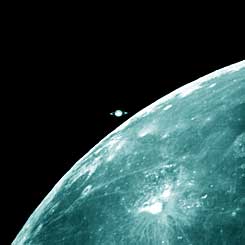On December 1, on the night between Friday and Saturday, it will be possible to see from Israel the eclipse of Saturn by the moon
Eran Ofek

Photo: K. G. Stank
On December 1, on the night between Friday and Saturday, it will be possible to see from Israel the eclipse of Saturn by the moon. For an observer from central Israel, Saturn will disappear behind the disk of the full moon at 5:21.5 Israel time, and will reappear about 40 minutes later, at 6:01.5 Israel time. Although the eclipse - which will occur when the moon is about 15 degrees above the western horizon - will be visible to the naked eye, a telescope will be needed to spot Saturn's rings before they disappear.
The next time that Saturn's eclipse by the Moon will be visible from Israel will be in March 2007.
The Moon, the Earth's closest neighbor in space, orbits the Earth once every 27.3 days. In this period of time it moves across the dome of the sky and passes in close proximity to various stars. For example, a month ago, on November 3, it was possible to see from Israel the moon passing very close to Saturn. Sometimes the Moon passes exactly between the Earth and a star or planet, and then an occultation occurs. In fact, this phenomenon is extremely common, but most of the occultations are of faint stars and require a telescope to spot them.
Rarer when the Moon covers a bright star or planet. If the star is bright enough, the phenomenon can be seen with the naked eye. Today, the main scientific value of observing occultation of stars on the Moon is to aid in accurate measurement of the Moon's position.
In the past, up until 20 years ago, astronomers used star occultations on the Moon to measure tiny changes in the Earth's rotation rate around its axis. Today this is done with much greater precision through special research satellites and ground observations using other methods.
